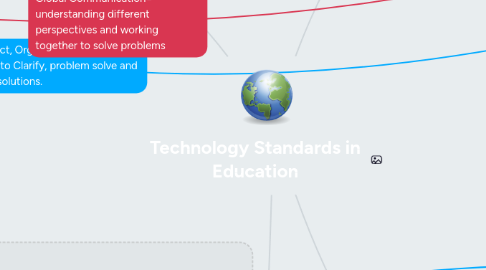
1. ISTE Standards For Students
1.1. Digital Citizen
1.1.1. Safe, Legal, and Ethical uses of technology
1.2. Global Collaborator
1.2.1. Using technology to work with others, get exposed to multiple perspectives and viewpoints and find solutions together
1.3. Computational Thinker
1.3.1. Using technology as a means to troubleshoot or problem solve, collect data, break down into steps or key concepts, and test solutions.
2. ISTE Standards For Teachers
2.1. Digital Citizen
2.1.1. Teachers practice and teach legal and ethical use of digital information including copyright issues and documenting sources correctly and when appropriate
2.2. Digital Age Work
2.2.1. Model and demonstrate knowledge and skills using various technology or digital tools to locate, analyze and evaluate information resources and support research and learning. Also to communicate and collaborate with students, peers, parents and community
2.3. Student Learning
2.3.1. Supporting creative and innovative thinking using technology and digital tools and resources. Using both face-to-face and virtual environments to collaborate and engage students to explore real-world issues, problem solving, and clarify student understanding and thinking.
3. Learning & Technology Policy Framework
3.1. Policy Direction 1: Student Centred Learning
3.1.1. Share & create knowledge, communicate and demonstrate global understanding and points of view through a range of digital resources. Apply digital citizenship and responsibility. Manage information and think critically to identify and solve problems
3.2. Policy Direction 4: Leadership
3.2.1. Staying current and up to date with best available technology to ensure the best possible learning outcomes. Help and support others through partnership opportunities and community
3.3. Policy Direction 5: Access, Infrastructure & Digital Learning Environments
3.3.1. Safe and secure access to high quality, current technologies for students, teachers and administrators. Infrastructure, community and private sector partnerships to ensure access and support digital learning environments.
4. ICT Program of Studies
4.1. Communicating, Inquiring, Decision Making & Problem Solving
4.1.1. Students will communicate through a variety of technologies, seek alternative view points, critically assess information, organize information, collaborate with others to help research and solve problems
4.2. Foundational Operations, Knowledge & Concepts
4.2.1. Students will understand the nature of technology and how it applies to themselves, work and society. Students will also demonstrate safe and ethical uses of technology
4.3. Processes for Productivity
4.3.1. Students will organize and manipulate data, communicate through a variety of digital tools and technology and share their findings through multimedia

